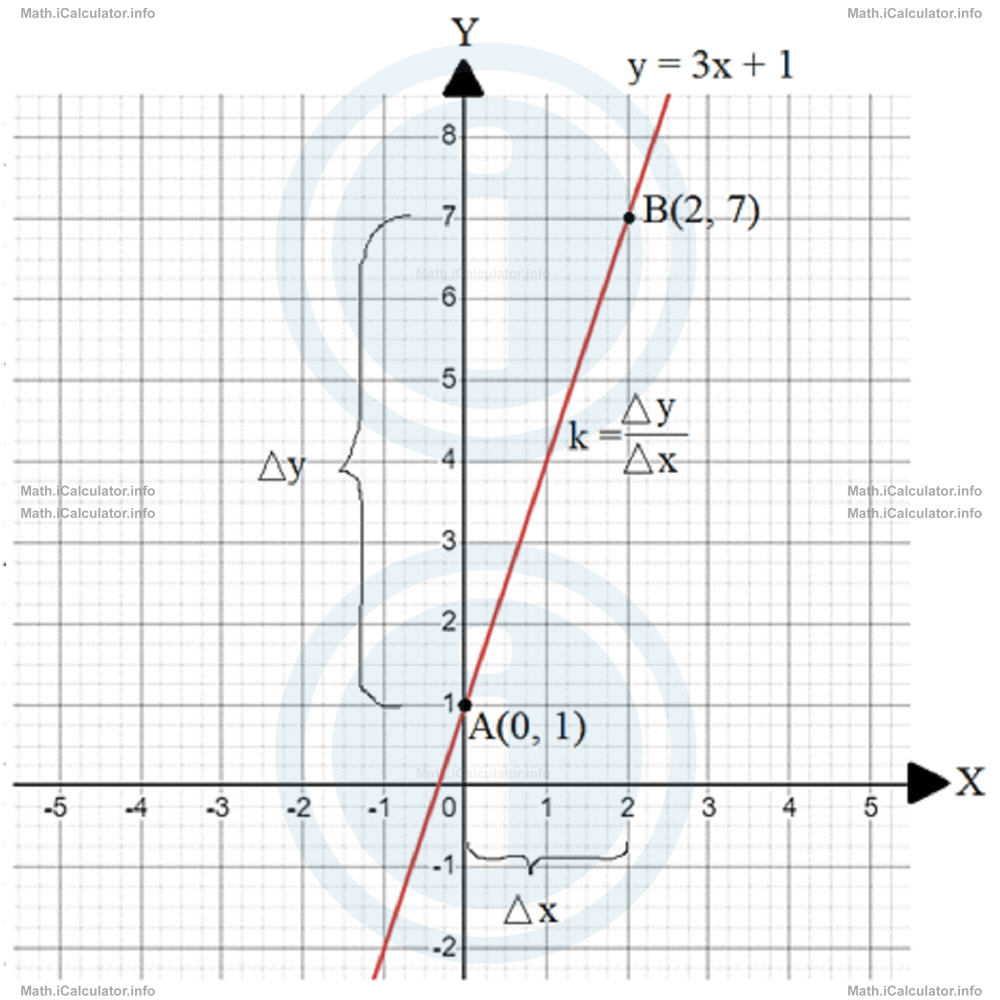Menu
Math Lesson 15.8.1 - Recalling the Concept of Gradient
Please provide a rating, it takes seconds and helps us to keep this resource free for all to use
Welcome to our Math lesson on Recalling the Concept of Gradient, this is the first lesson of our suite of math lessons covering the topic of Gradient of Curves, you can find links to the other lessons within this tutorial and access additional Math learning resources below this lesson.
Recalling the Concept of Gradient
In tutorial 14.2, we discussed the concept of the gradient of straight lines (linear graphs). We explained that the gradient is a concept related to the slope of the line, which shows how fast the vertical coordinate changes with respect to the change in the horizontal coordinate.
The procedure for finding the gradient k (or m) of a linear function described in that tutorial consists of the following steps:
Step 1: Choose two distinct points A and B on the graph (A is the leftmost point) and identify their coordinates xA, yA, xB and yB.
Step 2: Use the formula
to calculate the gradient of the given linear graph.
This procedure is carried out either analytically or graphically. For example, if we want to calculate the gradient k of the linear function y = 3x + 1, first we choose two points A and B from the graph (we do this by picking up two x-coordinates and calculating the corresponding y-coordinates. For example, if xA = 0 and xB = 2, the corresponding y-coordinates are
= 3 ∙ 0 + 1
= 1
and
= 3 ∙ 2 + 1
= 6 + 1
= 7
Therefore, the two points chosen from the graph are A(0, 1) and B(2, 7). Hence, the gradient of this line is
= 7 - 1/2 - 0
= 6/2
= 3
The following figure shows the solution to this problem graphically.

Why are gradients so important? Well, the gradient is a very crucial concept in functions theory because it shows how fast the value of a function changes. We assume the x-coordinate of a function as always increasing and see what happens to the corresponding y-coordinate. Thus, if four linear functions f1, f2, f3 and f4 have gradients k1 = -2, k2 = 0, k3 = 1 and k4 = 5 respectively, it means that:
The y-coordinate of f1 decreases twice as fast as the increase in its x-coordinate (because the gradient is negative);
The y-coordinate of f2 does not change at all, as the gradient is zero.
The y-coordinate of f3 increases as fast as its x-coordinate (because the gradient is + 1);
The y-coordinate of f4 increases five times faster than its x-coordinate (because the gradient is + 5).
You have reached the end of Math lesson 15.8.1 Recalling the Concept of Gradient. There are 4 lessons in this physics tutorial covering Gradient of Curves, you can access all the lessons from this tutorial below.
More Gradient of Curves Lessons and Learning Resources
Whats next?
Enjoy the "Recalling the Concept of Gradient" math lesson? People who liked the "Gradient of Curves lesson found the following resources useful:
- Recap Feedback. Helps other - Leave a rating for this recap (see below)
- Types of Graphs Math tutorial: Gradient of Curves. Read the Gradient of Curves math tutorial and build your math knowledge of Types of Graphs
- Types of Graphs Revision Notes: Gradient of Curves. Print the notes so you can revise the key points covered in the math tutorial for Gradient of Curves
- Types of Graphs Practice Questions: Gradient of Curves. Test and improve your knowledge of Gradient of Curves with example questins and answers
- Check your calculations for Types of Graphs questions with our excellent Types of Graphs calculators which contain full equations and calculations clearly displayed line by line. See the Types of Graphs Calculators by iCalculator™ below.
- Continuing learning types of graphs - read our next math tutorial: Quadratic Graphs Part One
Help others Learning Math just like you
Please provide a rating, it takes seconds and helps us to keep this resource free for all to use
We hope you found this Math tutorial "Gradient of Curves" useful. If you did it would be great if you could spare the time to rate this math tutorial (simply click on the number of stars that match your assessment of this math learning aide) and/or share on social media, this helps us identify popular tutorials and calculators and expand our free learning resources to support our users around the world have free access to expand their knowledge of math and other disciplines.